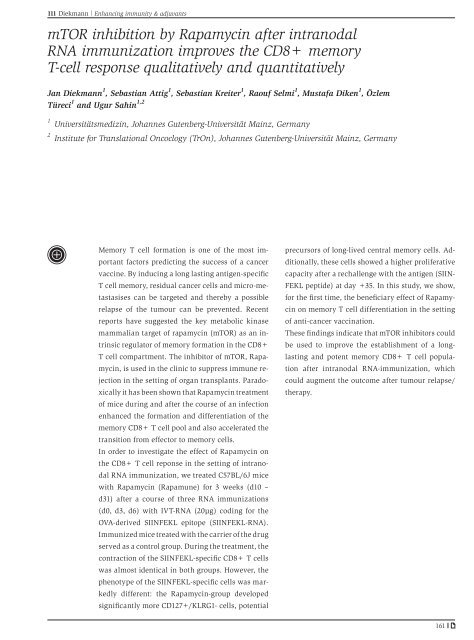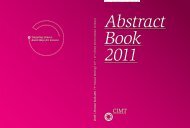Abstract Book 2010 - CIMT Annual Meeting
Abstract Book 2010 - CIMT Annual Meeting
Abstract Book 2010 - CIMT Annual Meeting
You also want an ePaper? Increase the reach of your titles
YUMPU automatically turns print PDFs into web optimized ePapers that Google loves.
111 Diekmann | Enhancing immunity & adjuvants<br />
mTOR inhibition by Rapamycin after intranodal<br />
RNA immunization improves the CD8+ memory<br />
T-cell response qualitatively and quantitatively<br />
Jan Diekmann 1 , Sebastian Attig 1 , Sebastian Kreiter 1 , Raouf Selmi 1 , Mustafa Diken 1 , Özlem<br />
Türeci 1 and Ugur Sahin 1,2<br />
1 Universitätsmedizin, Johannes Gutenberg-Universität Mainz, Germany<br />
2 Institute for Translational Oncoclogy (TrOn), Johannes Gutenberg-Universität Mainz, Germany<br />
Memory T cell formation is one of the most im-<br />
portant factors predicting the success of a cancer<br />
vaccine. By inducing a long lasting antigen-specific<br />
T cell memory, residual cancer cells and micro-metastasises<br />
can be targeted and thereby a possible<br />
relapse of the tumour can be prevented. Recent<br />
reports have suggested the key metabolic kinase<br />
mammalian target of rapamycin (mTOR) as an intrinsic<br />
regulator of memory formation in the CD8+<br />
T cell compartment. The inhibitor of mTOR, Rapamycin,<br />
is used in the clinic to suppress immune rejection<br />
in the setting of organ transplants. Paradoxically<br />
it has been shown that Rapamycin treatment<br />
of mice during and after the course of an infection<br />
enhanced the formation and differentiation of the<br />
memory CD8+ T cell pool and also accelerated the<br />
transition from effector to memory cells.<br />
In order to investigate the effect of Rapamycin on<br />
the CD8+ T cell reponse in the setting of intranodal<br />
RNA immunization, we treated C57BL/6J mice<br />
with Rapamycin (Rapamune) for 3 weeks (d10 –<br />
d31) after a course of three RNA immunizations<br />
(d0, d3, d6) with IVT-RNA (20µg) coding for the<br />
OVA-derived SIINFEKL epitope (SIINFEKL-RNA).<br />
Immunized mice treated with the carrier of the drug<br />
served as a control group. During the treatment, the<br />
contraction of the SIINFEKL-specific CD8+ T cells<br />
was almost identical in both groups. However, the<br />
phenotype of the SIINFEKL-specific cells was markedly<br />
different: the Rapamycin-group developed<br />
significantly more CD127+/KLRG1- cells, potential<br />
precursors of long-lived central memory cells. Additionally,<br />
these cells showed a higher proliferative<br />
capacity after a rechallenge with the antigen (SIIN-<br />
FEKL peptide) at day +35. In this study, we show,<br />
for the first time, the beneficiary effect of Rapamycin<br />
on memory T cell differentiation in the setting<br />
of anti-cancer vaccination.<br />
These findings indicate that mTOR inhibitors could<br />
be used to improve the establishment of a longlasting<br />
and potent memory CD8+ T cell population<br />
after intranodal RNA-immunization, which<br />
could augment the outcome after tumour relapse/<br />
therapy.<br />
161



